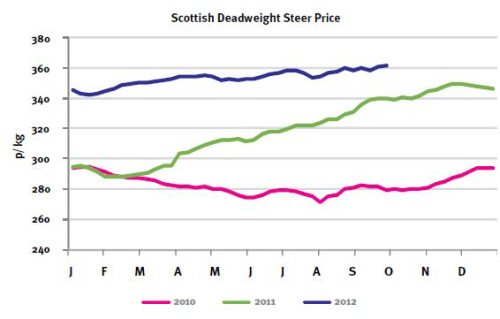



Cattle Enterprise Profitability in Scotland, 2011 Discussed
The business success for 2011 of 116 suckler herds and 50 cattle finishers was analysed by Quality Meat Scotland. Although improvements were made overall on 2010, many farms do net make a net profit. The survey tells of the variation that exists across Scottish beef producers.The results of the 2011 Scottish calf and lamb crop year survey show improvement in
margins over the past year across all enterprise types surveyed. Nevertheless, they
still reveal the difficulty among suckler herds and hill sheep flocks to achieve a positive
margin from the market place.
Only 30 per cent of the suckler herds surveyed reported
a positive net margin from which to pay family labour and reward the risk capital
invested in the business.
Although there has been general improvement in profitability, the survey results
continue to show significant variation in levels of financial and technical performance
within the industry.
In common with previous years there are a number of recurring
themes that characterise top performance.
Top producers continue to be characterised by:
- High physical, or technical, performance;
- Strong control over costs;
- Maximising returns from the market place
Across suckler herds, those in the top third of gross margin per animal achieved higher output through selling heavier calves while most also achieved higher calf rearing percentages and generally lower herd replacement rates. They also typically received 3-7 p/kg lwt more for the calves they sold.

Suckler herds in the top third of financial performance were also characterised by
strong variable cost control. In all cases those in the top third had lower total variable
costs than the average while achieving higher output. However, with the exception
of hill suckler herds these business had higher fixed costs per cow than the average
but when measured against kg of output all carried lower fixed costs than the average
except among the lowground sample.
Financial returns among store cattle finishers reflect the changing circumstances of the market place. This year those in the top third tended to have bought the smallest cattle and finished them over the longest period reflecting the benefits of selling into a rising market.
Last year the picture was the opposite as a flat market benefited those who finished cattle over the shortest period. Nevertheless, despite a longer finishing period those in the top third did have strict control over variable costs, spending around 3 per cent less than the average, but because of a longer finishing period they did carry higher fixed costs.
The LFA hill suckler herds surveyed had an average gross margin of £279 per cow. The
top third averaged £411 per cow gross margin, an improvement of £132 per cow. The
top third achieved a positive net margin of £83 per cow against the average of (-)£95.
Of the eighteen producers surveyed five achieved a positive net margin, emphasising
the challenges of farming in an extensive way on severely disadvantaged land.
The LFA upland suckler herds were split into two categories, one group selling at weaning
and a second group selling yearling stores. Those selling at weaning made an average
gross margin of £258 per cow, but were outperformed by their counterparts selling
yearlings who achieved an average gross margin of £375 per head.
Top third producers
selling at weaning made £370 gross margin per cow with 12 per cent more liveweight produced
per cow than the average while at the same time keeping variable costs 10 per cent lower.
Of
those selling yearlings, the top third achieved a gross margin of £497 per cow. Again
variable costs were strictly controlled and compared to the average were 25 per cent lower
while still producing 3 per cent more liveweight per cow. One quarter of businesses selling
calves at weaning achieved a positive net margin. In contrast among those selling
yearlings, 40 per cent of the businesses achieved a positive net margin.
Non-LFA suckler herds reported an average gross margin of £296 per cow while those
in the top third achieved a gross margin of £397. A significant contributor to this
improvement was the 7 per cent greater sale weight per cow. Although the top third did
manage variable costs to a level 6 per cent below the average they did carry higher fixed costs
which reduced their advantage at net margin level to £27 per cow. Nineteen percent
of businesses surveyed achieved a positive net margin.
Rearer finisher businesses surveyed recorded an average gross margin of £412 per cow
with the top third averaging £568. However, although considerably improved from last
year, the average net margin remained negative at (-)£25. Thirty-six percent of the
businesses surveyed achieved a positive net margin.

Cereal based cattle finishers surveyed reported an average gross margin of £128 per
beast and a net margin of £56. Those in the top third achieved an £85 improvement in
net margin over the average. Indeed nearly three-quarters of businesses in the survey
reported a positive net margin.
Forage based finishers made an average gross margin of £190 per beast and reported
a net margin of £14. Those in the top third achieved a £126 per beast improvement
in net margin achieved largely through selling heavier cattle and having the biggest
spread between buying and selling price. Fifty-three percent of those surveyed
achieved a positive net margin a significant improvement on the year.
Across all suckler herds surveyed, 30 per cent made a positive net margin; a significant
improvement from the 14 per cent who achieved this in the 2010 survey. Sixty percent of
finishing enterprises achieved a positive net margin compared to 49 per cent in 2010.
Further ReadingGo to our previous news item on this story by clicking here. |


